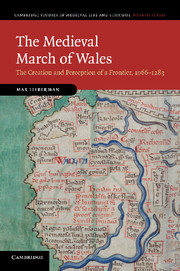Book contents
- Frontmatter
- Contents
- List of maps
- List of tables and illustration
- Preface
- List of abbreviations
- INTRODUCTION
- 1 A BORDER REGION?
- 2 THE MAKING OF A BORDER ARISTOCRACY
- 3 WARFARE AND DIPLOMACY
- 4 THE EXTENT AND NATURE OF THE MILITARY FRONTIER
- 5 THE MILITARIZATION OF SOCIETY
- 6 THE SHAPING OF ADMINISTRATIVE TERRITORIES
- 7 THE BORDER LORDSHIPS AND THE ENGLISH STATE
- CONCLUSION
- Select bibliography
- Index
INTRODUCTION
Published online by Cambridge University Press: 06 July 2010
- Frontmatter
- Contents
- List of maps
- List of tables and illustration
- Preface
- List of abbreviations
- INTRODUCTION
- 1 A BORDER REGION?
- 2 THE MAKING OF A BORDER ARISTOCRACY
- 3 WARFARE AND DIPLOMACY
- 4 THE EXTENT AND NATURE OF THE MILITARY FRONTIER
- 5 THE MILITARIZATION OF SOCIETY
- 6 THE SHAPING OF ADMINISTRATIVE TERRITORIES
- 7 THE BORDER LORDSHIPS AND THE ENGLISH STATE
- CONCLUSION
- Select bibliography
- Index
Summary
More than two centuries elapsed between the Norman conquest of England and the English conquest of Wales. One year after their victory at Hastings in 1066, William the Conqueror's knights and barons had launched their first raids across the Welsh border. Yet Wales was not brought under the direct control of the kings of England until 1282–3, when Edward I fought his second Welsh war, Llywelyn ap Gruffudd, the last native prince of Wales, was killed, and Llywelyn's brother Dafydd was executed. In achieving dominion over Wales by military force, Edward I outdid his own campaigns of 1276–7 as well as all those of his Norman and Plantagenet predecessors. After William the Conqueror himself went on an expedition to St David's in 1081, Wales was attacked by William II in 1095 and 1097 and by Henry I in 1114 and 1121. Stephen was prevented by civil war from campaigning in Wales, but Henry II led armies there in 1157, 1158, 1163 and 1165. Richard I preferred the Holy Land and France as arenas for military exploits, but Wales was invaded by John in 1211 and 1212, and repeatedly, between the 1220s and the 1260s, by Henry III or his deputies. Yet none of these campaigns led to a Norman or English ‘conquest’ of Wales, even though some may well have aimed at doing so, notably the one which failed in 1165 and the one which was abandoned in 1212.
- Type
- Chapter
- Information
- The Medieval March of WalesThe Creation and Perception of a Frontier, 1066–1283, pp. 1 - 22Publisher: Cambridge University PressPrint publication year: 2010



